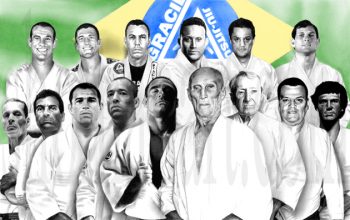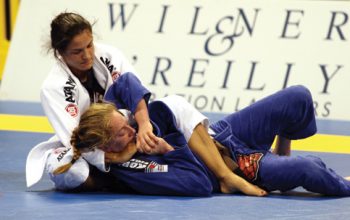Brazilian Jiu Jitsu Posted by carol on Aug 25, 2017 in Brazilian Profile, Culture, Customs, Entertainment, Sports
Oi a todos! Hey, everybody! Como estão se sentindo hoje? How are you feeling today?
Have you ever found yourselves slightly confused at the sight of two sweaty men (or women) fiercely rolling around on the floor together on TV? You were probably inadvertently watching a Brazilian Jiu-Jitsu, or BJJ combat. If you’re into sports, then you’re likely to have heard about this martial arts modality that has Japanese roots and came to Brazil in the early 1900, becoming internationally acclaimed around the ‘80s. Prontos para lutar? Ready to fight?
Palavras-chave | keywords: esportes (sports), artes marciais (martial arts), combate (combat), treinamento (training), força (strenght), técnicas (techniques), corpo (body)
It is difícil (difficult) to precisely determine its origins, but it is believed that Jiu-Jitsu dates back to medieval times and was possibly desenvolvido por (developed by) Samurais in feudal japan as a resource to combater (fight) opponents without weaponry when necessary. But how did this ancient practice came to be conhecido (known) as a distinctly Brazilian combat form?
A família Gracie – The Gracie family

The legendary family notorious for being the founders of Brazilian Jiu Jitsu first came into contact with the martial art by a Japanese immigrant and later naturalized Brazilian Mitsuyo Maeda, a key figure in the sport who would perform public demonstrations so as to ensinar (teach) the audience more about Jiu Jitsu. Carlos Gracie, son of influential businessman from the northeast of the country Gastão Gracie, attended one of these performances and decided to pursue a career with the help of Maeda, who took him as him student. In 1925, Carlos opened his first Jiu Jitsu academia (gym) in Brazil, cleverly marketed as “if you want a broken arm, come find the Gracie gym”. The family produced a whole lineage of black belts and instructors. Carlos was the father of vinte e um (21) children and surprisingly treze (13) of whom earned the rank of faixa preta (black belt) in Brazilian Jiu-jitsu.
The Gracies later moved to Rio de Janeiro, where the youngest filho (son) Hélio could only assistir (watch) his older brothers during training due to his frail constitution. Um dia (one day), however, his brother was running late and Hélio decided to step in, teaching an entire aula (class) based solely on his previous observations. It is said that the alunos (students) enjoyed his method so much that they required him to ficar (stay) and become their permanent instructor.
Given Hélio’s slim and fragile figure, his major contribution to the sport was introducing innovations that would transform Jiu Jitsu into what it is known hoje (today) and maybe the reason why it is so closely associated with the Gracie name (and, by extension, Brazil). Hélio modified some established techniques so as to more appropriately suit his non-athletic build, making it more effective and possible for lutadores (fighters) to defend against a larger opponent, taking them to the ground so as to maximize the advantage instead of relying solely on força física (physical strenght). Hélio’s approach, therefore, was seeking more efficiency in the moves regardless of a person’s tamanho (size), peso (weight) or atributos físicos (physical attributes).
Brazilian Jiu Jitsu nowadays is very focado em auto-defesa (self-defense focused) and it involves a lot of ground fighting and less standing. Fighters should aim at a dominant position, trying control and overpower their adversary using leverage and skill, not so much strength. BJJ became specially popular in the ‘90s and it is now a prestigious, registered federation. The name was adopted when touring pelo mundo (around the world) to refer to the specific and unique style that characterizes it. One can find BJJ gyms basically anywhere, from Singapore to Australia and India. If you’re interested, check it out and see if there are any perto de você (close to you) and start training!
Tenham um bom fim de semana! Have a great weekend!

Build vocabulary, practice pronunciation, and more with Transparent Language Online. Available anytime, anywhere, on any device.





Comments:
JoyElaine Seymour:
Review the use of American English “come” and “came.” Appears to be some confusion in one place. Love your blogs!
carol:
@JoyElaine Seymour Hey! Thanks for reading our blog 😀